Basic Skills and Technology
- not a Contradiction, but a Completion
T3 - Austria and DERIVE User Group
| Are certain basic - manipulating and other - skills still necessary in math teaching? If so, then we should talk about which ones and in which amount. Some examples shall demonstrate that we can use modern computer and hand held technologies to encourage pupils and students of all levels to practise those skills which might be neglected in many cases using technology in math education. The examples presented have proved to be successful in classes but certainly there are many possibilities to improve the basic ideas in many ways using the features of all resources available at the moment. |
At almost all discussions on the use of CAS in teaching mathematics the question appears mathematical basic (manipulating) skills are lost by using computers or not. At the same occasions it is emphasized by the members of the discussion that there is a need in investigating which basic skills are still necessary and in which amount.
I start from my point of view that - at this moment - we cannot and should not do without certain basic skills in mathematics. I feel unable to give any forecast for the future. I am sure that we could significantly rise the acceptance of technology in teaching mathematics by sceptic and critical teachers or technology refusing educational systems if we would be able to apply technology not only to present real life problems or new - for some people radical - didactical approaches but also to improve basic calculating and manipulating techniques and mathematical capabilities. We can very consciously practise all those techniques using technology which could be neglected by a (too?) intensive use of the technology.
It would be necessary
and helpful to set up a list of such basic skills which teachers would
like to have practised by their students. From my own experience I can
say that it is very useful to provide tools for the pupils - or students
which enable them to help themselves in case of troubles and difficulties.
It is not sufficient to have a textbook with lots of examples followed
by the solutions and the students don´t find the way from the problem
to the solution. At the other hand it is not sufficient to have problems
followed by a step by step solution. Sometimes it could be useful to work
out a student - computer interactive strategy to help overcoming some
deficiencies.
I collected
some skills which could be practised and improved using computers (that
is only a glimpse and I know that the discussion could lead to the conclusion:
"we don´t need this or that any longer in computer age".).
- Estimating numerical results
- Working with percentages
- Working with fractions
- Applying elementary algebraic operations (factorising, ......)
- Recognising types of functions by their graphs
- Using functions (Relations) and their various representations
- Solving equations (linear, quadratics and systems of equations)
- Calculus techniques
- Improving 2D and 3D imagination
- Calculating mentally
- Transformations of function
Incited by ideas from Jan Vermeylen (Belgium), Heinz Rainer Geyer (Germany) and Johann Wiesenbauer (Austria) I tried to produce training- and practise programs for my students (secondary level II), which I want to present as seed for further developments. The platforms are DERIVE and the hand held revolution, TI-92/89. The only reason for this choi ce is because I mainly use those to CAS. I am sure that you can use each of the available systems. The goal should remain the same: developing softeware products which will meet our - the teachers´ and the students´- very special wishes, ideas and visions.
I have tried to work
with such tools since long. In my first years working with computers I
produced programs written in BASIC. It is quite nice to follow the development
of hard- and software on one application: The Rule of Vieta, presenting
random generated examples.
I will allow a nostalgic look into the program code – I am happy to have
done this a couple of years ago. It helps a lot to write programs with
modern software tools.



I rediscovered my old BASIC-program, converted it to the TI´s syntax and my students practised
"Vieta" in the lessons, in the breaks, at home, sometimes in the train or sometimes just for fun or – how a girl told us – as a means to find her concentration before learning for other subjects.





POL(n) produces n random number generated problems.
The students have to factorise using pencil and paper and then check their solution.
The file could easily be changed to practise special types of factorizations if necessary.
Settings of factorization modes - Rational, Complex, ... – gives a nice variety of points of view.
(This example is some years old and could be adapted to other platforms)
Then it could look like the next trainings tool (JosefBöhm). My students like it and use it:



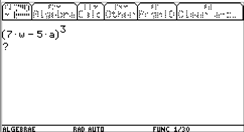
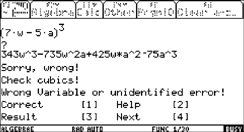
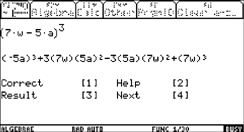
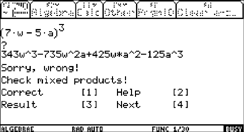




J. Vermeylen produced a DERIVE file to have lots of "standard problems" dealing with arithmetic series. "verschil" is Dutch, it is the difference d of the series.
The next screen shot
is the final result of a very busy discussion in the DERIVE community
to produce a sort of report when solving an equation and applying various
equivalence transformations.
Johann Wiesenbauer - who else - solved the problem with a very
sophisticated tool.
So students are able to reproduce, what they have done using paper and pencil and check their results with the computer´s ones. They find their mistakes by themselves.



Another course of the Lines-Menu: "Find two points!"
You enter the coordinates of two points which should ly on the given line, see two "balls" on the grid and if you are lucky the line passes the two "balls". The linear function appears in various representations (explicit, implicit, ..)


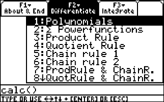
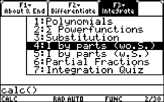
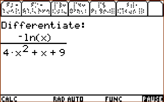









Example 2:


Explain the last part in the edit line:
-4 * gn:
How
to work with an expanding factor
ew( )? -4 * ew(....).
Explain the relation between left and right hand side in the last row of the history area:

In addition to all the wellknown reasons to include modern technologies into mathematics teaching, which I like and support in a very high degree, I also use the technology in many cases to improve manipulatings skills which seem to be no longer of any importance by using these technologies.
If
you would like to try some of the tools presented in this paper, then
please contact me. I would appreciate any suggestions and ideas dealing
with this topic. The TI-92/89 programs algebra(), lines() and calc() are
distributed together with the bk teachware books (references).
Very recently I turned back again to my "first love" DERIVE
- with version 5. Fortunately my colleague Tania Koller and I could split
a class for mathematics and we are working with DERIVE in the PC-Lab.
Using the programming capabilities of DfW5 I tried to transfer
my DERIVE for DOS - TI-92 - ideas back on the PC-screen.
And it worked wonderful:
Although the screen shot is in German, but I think that you can follow:


qu= presents a square a random generated square, ku= a cube, tr= a square of a trinomial, pr= a product of two binomials of form (a var1 + b var2) (c var1 + d var2) and the student is asked to perform the multiplication mentally, di= gives a product of form (a var1 + b var2) (a var1 - b var2) and finally te= brings a randomly chosen task on the screen. qub(n)= presents n problems of form qu, etc.
You can see that the learning and practising tool will not only provide the correct result with res=, but and that is important gives an advice where to look for the mistake.



ch= gives rational linear factors only,
chw= returns also the irrational way and if
appropriate
chk= shows the complex factorization.
References:
[1] Geyer, H. R
,Vermeylen, J.,Wiesenbauer, J., Welke St. (1998). From Nested Ifs to
a MACRO for
DERIVE. DERIVE & TI-92 Newsletter #31
[2] Vermeylen,
J. and Böhm J. (1995). Vieta by Chance. DERIVE & TI-92 Newsletter
#20
[3] Geyer,
H. R. (1997). The "Delayed” Assignment :==. DERIVE & TI-92
Newsletter #27
[4] Böhm,
J. (1998). Train your skills with the TI-92. DERIVE & TI-92
Newsletter #31
[5] Böhm J.
(2000). Mathe Trainer I. bk teachware, Hagenberg, Austria
[6] Böhm J.
(2001). Maths Trainer I. bk teachware, Hagenberg, Austria (to appear)
[7] Fortin,
Ph. (1999). Introduction au Calcul Formel. T3 Europe
- France
[8] Böhm J.
(2000). DERIVE & TI-92 Newsletter #40